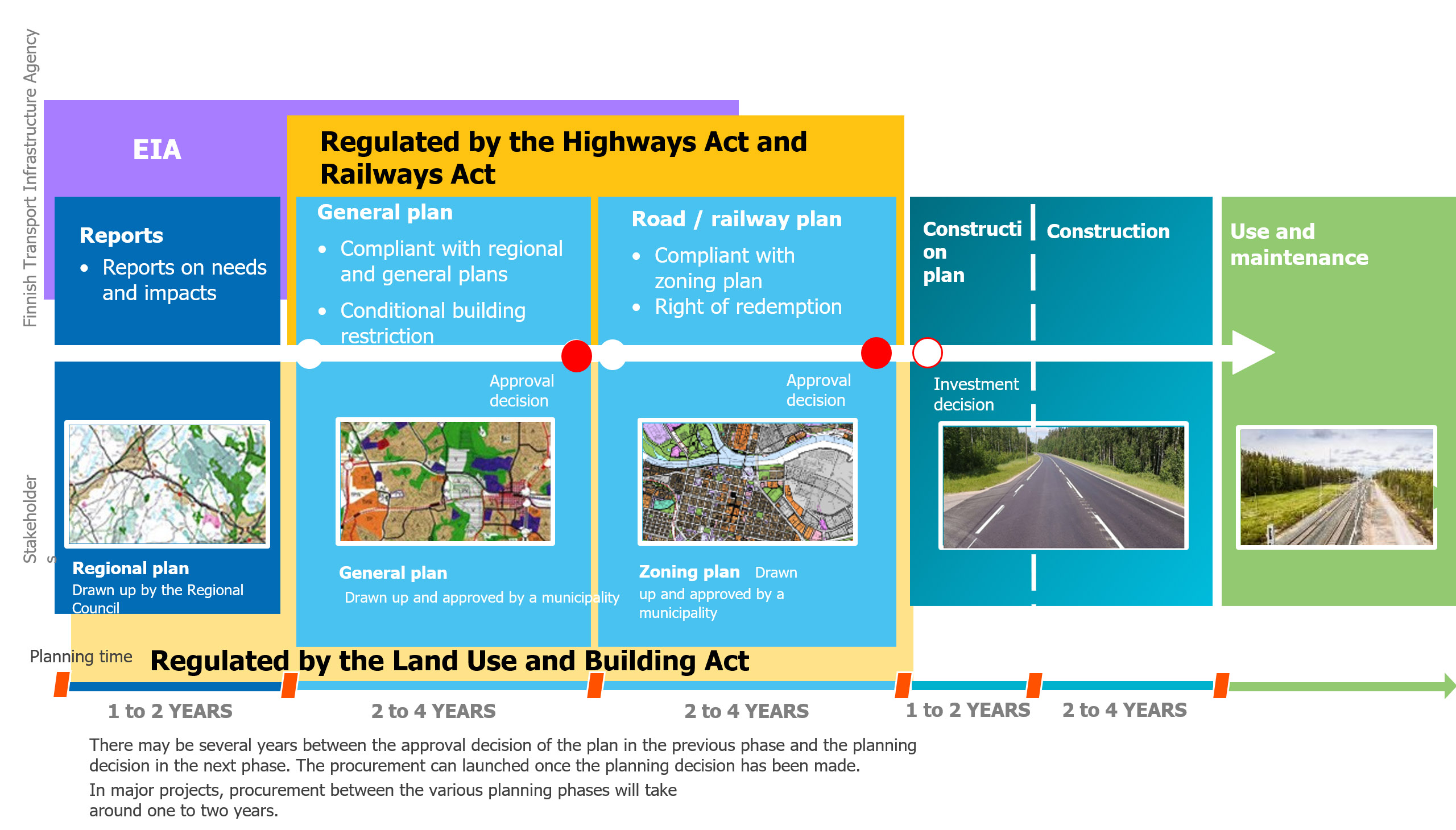Project planning phases
The planning of transport infrastructure projects is a process that becomes more detailed as it advances. The precision of planning and decision-making for each phase will be coordinated with land use planning. The starting points for road planning are described in the basis for design section.
The planning of road and railway projects progresses in stages:
1) preliminary study
2) general plan
3) road and railway plan and
4) construction plan
Not all planning phases are always needed if the impacts of the project are assessed to be minor. If necessary, phases can be combined.
The general plan for waterway projects is followed by an application for a permit in accordance with the Water Act to apply for the rights to implement the project. The water permit process is followed by construction planning, just as in road and railway projects.
The planning work related to a road project is always based on the monitoring of traffic and road conditions and the conditions of the environment near the road and anticipating their development. Railway projects are underpinned by the development of the railway network and the maintenance of its operability. Waterway projects are based on the development of the routes needed for merchant shipping and other waterway traffic.
When planning a new road or the upgrade of an existing road or a new railway or the upgrade of a track section, planning must be based on a plan described in the provisions laid down in the Land Use and Building Act. The planning of waterways is not based on land use planning. Instead, the location of the waterway is decided on in a permit that complies with the Water Act. However, planning matters are taken into account when granting the permit.
The phases for road and railway planning are related to land use planning as follows:
The preliminary study phase includes an evaluation on the need and timing of road and rail projects at the approximate level of accuracy of the regional plan and the general plan. During the preliminary study phase, there may be numerous alternative options for the location of the route. The number of alternatives will decline as planning becomes more detailed.
Changes caused by societal development in travel needs and traffic conditions are examined during the preliminary study phase, and the actions required to meet the goals set for the development of traffic conditions are planned. The outcome of the preliminary study is a project or several projects for which preliminary examinations have been conducted of possible alternative actions, including the related impacts and costs.
General planning covers land use planning either at the general plan level or the local detailed plan level. The general plan defines the approximate location of the road and railway, the need for space and how these will relate to surrounding land use.
The general plan presents the basic technical and traffic solutions for the road or railway and the principles underlying the prevention of environmental damage. In planning, a level of detail is selected which ensures the plan’s technical, financial and environmental feasibility. If legislation requires an environmental impact assessment (EIA), the transport infrastructure project’s environmental impact is usually assessed according to the Act on Environmental Impact Assessment Procedure during the general planning phase. The EIA procedure can also be applied at the road/railway planning phase. The EIA procedure is described on the ‘Impact Assessment’ tab. The Finnish Transport and Communications Agency (Traficom) makes an approval decision on the general plan.
The phases of general road planning are described in more detail in a separate brochure on the progress of general planning.
The preparation of a road and railway plan is the detailed planning of roads and railways that aims at the implementation of the project. The road area and railway area needed on the basis of a valid road and rail plan will be taken possession of for the purpose of the construction of the road and railway. The road and railway plan correspond to the precision of a local detailed plan. The road and railway plan determines the precise location of the route and areas required for it, and measures necessary to the prevention of negative traffic impacts.
The road plan also presents intersections with highways and private roads and other road arrangements, and arrangements for pedestrian and bicycle traffic and public transport. It is sometimes necessary to make a revision to an approved road and railway plan. This is processed similarly to the original plan, unless the impact of the change is so minor that agreement with real-estate owners is sufficient. Once financing has been secured, highway and track construction can begin. The Finnish Transport and Communications Agency (Traficom) makes an approval decision on both the road plan and the railway plan.
The phases of road and railway planning are described in more detail in separate brochures on road planning and railway planning.
Construction planning is related to the immediate implementation of the project, is often included in the contract and is only carried out once the project funding has been arranged.
Infographic: Progress of a traffic infrastructure project

